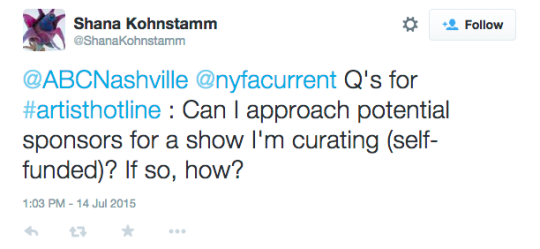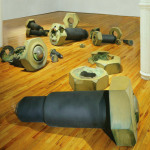ASK #ARTISTHOTLINE: SPONSORSHIPS
NYFA’s #ArtistHotline kicked off last month with a lot of insightful questions and much needed artist conversations. Discussions ranged from selling your artwork to starting a non-profit. You can read the whole recap here.
A few questions needed more than 140 characters to answer, so we’re delving into our Twitter feed to see how we can provide further resources. First up from @ShanaKohnstamm, “Can I approach potential sponsors for a show I’m curating (self-funded) If so, how?
Well, raising money for your exhibition can be a difficult task. It involves removing yourself from the creative process and actively asking people for money. The whole process can feel a bit daunting. Where do you begin? How do you focus on your artwork and find financial resources simultaneously? Sounds difficult, but trust us it can be done.
As an artist, you automatically enter the world of entrepreneurship. It’s important to have ingenuity and a strong foundation in business basics to navigate your career, especially when it comes to M-O-N-E-Y. Learning how to ask for sponsorship fits neatly in your lifelong “artist tool kit”, along with budgeting, grant writing and archiving. The list is endless, but…let’s start with a few steps on how to obtain sponsorship and most importantly, how to build successful partnerships.
Step 1: What do you want from sponsorship?
Your first response may be “I need money!” However, sponsorship from a business or individual can work in a variety of ways. Do you need access to a venue? Or help with marketing your exhibition? Your first step is deciding what you want out of sponsorship. Think broadly about your needs. For example, you may ask the businesses to donate catering for the event. Whatever the ask, be clear on why you’re making this request and how it’s mutually beneficial.
TYPES OF SPONSORSHIP OPPORTUNITIES
Financial Sponsor
Companies can sponsor exhibitions or artist projects by directly providing a cash contribution. The amount will vary depending on your appeal. As a financial sponsor, they may require exclusive benefits as part of the sponsorship agreement. This can include special recognition at the event, wall signage or mentions on social media. Typically, businesses are looking to expand their audience. Before approaching potential sponsors, investigate what their specific needs are.
In-kind Donations
In-kind sponsorship is a donation to an event of goods or services. The donation of specific items, like food or alcohol, can help offset the overall expense of the exhibition.
Fiscal Sponsorship
Fiscal sponsorship is a unique opportunity to help artist discover funding opportunities through an affiliation with a tax-exempt 501©(3) nonprofit. Once fiscally sponsored, artists can apply for grants from foundations that are usually restricted to nonprofits, and offer individual donors the benefit of a tax-deductible contribution.
NYFA’s fiscal sponsorship program supports artists of all disciplines. The program is structured to help artists maximize their fundraising efforts – whether you need support for an exhibition or producing a performance.
Step 2: Identify Potential Sponsors
Make a list of organizations you’d like to partner with. Start with local businesses in your community, along with art organizations you’re currently affiliated with. Businesses are increasingly aware of how artists impact the surrounding community. Your partnership with the company can positively influence your neighborhood long-term.
Aligning yourself with an like-minded organization is the first step to developing a lasting partnership. As you identify sponsors, it’s important to know as much as possible about their audience as well.
Before you make a call or send out an email, do your research. Clearly state all the sponsorship benefits and expand on how it’s relevant to their target audience. You’re creating a business proposal and want to be well-prepared before contacting a company. This means knowing who is in charge of sponsorship requests and what their overall expectations are. Don’t be afraid of cold-calling or scheduling an one-on-one presentation on why they should sponsor you. Depending on the organization, different approaches will be needed.
Step 3: Make a list of Sponsorship Benefits
Develop a succinct list of reasons why they would benefit from giving you what you’re asking for. Businesses want to know what they’re getting in return for supporting your exhibition.
According to Alyson Stanfield of Art Biz Blog, benefits might include the following:
- Listing or logo on the invitation
- Listing or ad in a program, brochure, and/or newsletter
- Mention in press release
- Name or logo on event web page or blog posting
- Name or logo on wall or table signage
- Name or logo in a catalog, which you can have printed just for your sponsors
- Display table for sponsor to promote products or services
- % Discount on purchase of art
- Acknowledgment in any spoken program at the event
- Free tickets to the event (number of complimentary tickets increases with giving level)
- VIP tour for a specific number of people
- Studio visit with cocktails
Step 4: Look at Your Contacts
As an artist you have a myriad of unique relationships – friends, family, work colleagues – review your network and find possible connections. Chances are you may have a relationship that can lead to an introduction with a business.
Step 5: Make your Pitch
Strive to be concise and intriguing with your pitch. Share the reasons why your exhibition is unique and adds value to the company. Remain persistent and remain flexible with your outreach strategy. Remember, there is no single approach to getting sponsorship. With careful research and planning you can discover ways to build viable partnerships.
Send us your art-related questions using the hashtag: #ArtistHotline at any time and follow @nyfacurrent for updates.
– Glory Edim, Program Associate, Online Resources
Inspired by the NYFA Source Hotline, #ArtistHotline is a new initiative dedicated to creating an ongoing online conversation around the professional side of artistic practice. Our goal is to help artists discover the resources needed, online and off, to develop sustainable careers.
By connecting on social media, artists and art service organizations can establish a shared platform of knowledge, increase collaboration, and build rewarding long-term partnerships.
This initiative is supported by the Emily Hall Tremaine Foundation





